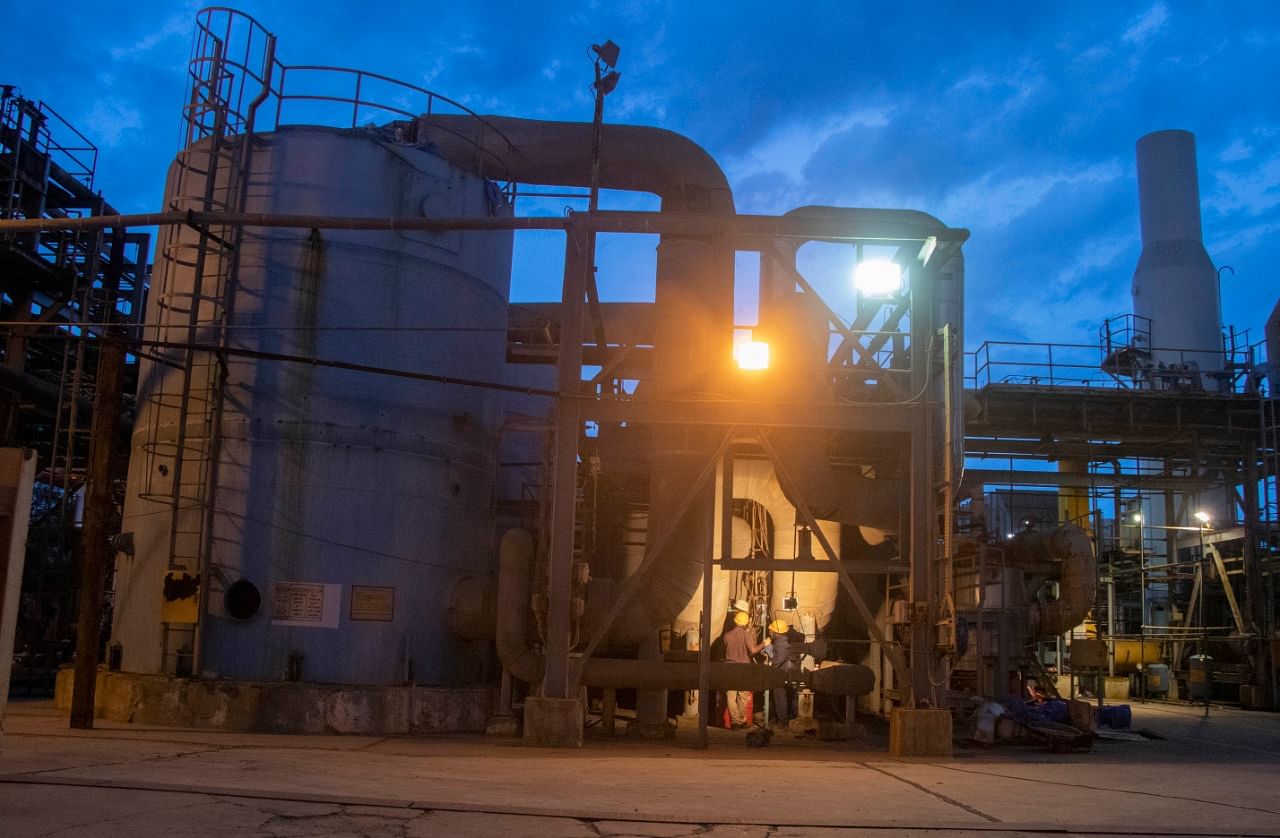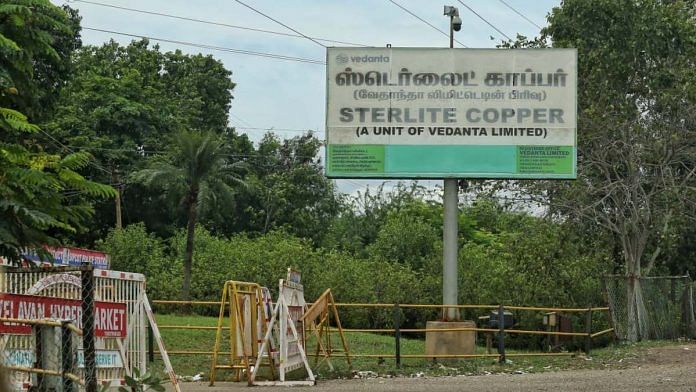Thoothukudi: Around 10 km from the Thoothukudi district limits, in the Sipcot Industrial Estate, personnel of the Tamil Nadu Special Force and state police stand guard outside the Vedanta Sterlite Copper plant as a reminder of its controversial past.
Shut down three years ago following protests by local residents who saw it as a health hazard, the plant sputtered back to life this month as the potential answer to the oxygen requirements of the state’s Covid patients.
In its past, the plant generated oxygen to aid the copper smelting process. The same capacity is now being leveraged in the Covid battle.
However, this temporary resurrection of the plant has been dogged by challenges.
Just a day after the plant started oxygen production on 13 May, a snag — blamed on the shutdown, which took a toll on the machinery — brought operations to a halt again. The production was resumed Tuesday, but sources in the plant said most of the oxygen gas produced goes to waste in the absence of requisite capacity to convert it to liquid form.
Of the two oxygen generation facilities at the plant, with a total capacity of 1,050 metric tonnes a day, only one has been deployed since it was found to have weathered the shutdown better.
While certain issues need to be ironed out, the plant has many expectations riding on it.
The neighbouring districts of Thoothukudi (formerly Tuticorin) and Tirunelveli — which lie towards the state’s southern tip — are eyeing the Sterlite plant with hope. Similar expectations are voiced by administrative officials in Madurai, which lies an entire district away from Thoothukudi.
On its part, the company says it can cater to the demands of Kanyakumari and Trichy as well.
Even Thoothukudi residents, who mounted an intense agitation against the plant in 2018, are on board with the initiative despite their concerns. The threat of the pandemic is the driving factor in this turnaround, as is the administration’s promise that the plant will be shut down again in four months.
As of 18 May, according to the state’s health bulletin, Tamil Nadu had 2,42,929 active Covid cases and 364 deaths. On the same date, the state saw its highest-yet surge in daily cases, with 33,059 new infections.
Tamil Nadu’s daily consumption of medical oxygen is estimated at 440 metric tonnes, which is projected to double by 21 May, Chief Minister M.K. Stalin wrote in a 7 May letter to the central government where he demanded a higher oxygen allotment for the state.
There are currently four private companies that are altogether supplying 490 metric tonnes of oxygen/day to Tamil Nadu.
Also Read: Actor’s death fuels vaccine hesitancy in Tamil Nadu amid Covid surge, misinformation adds fire
Challenges at plant
The Sterlite Copper plant is spread over a sprawling 300 acres. In its former form, the plant was equipped with oxygen generation facilities because the gas was required to accelerate the heating process during copper smelting.
The Tamil Nadu government accorded approval for oxygen generation at Sterlite Copper on 26 April. The Supreme Court gave Vedanta the go-ahead on 27 April.
On the first day of resumed operations, the plant produced 4.8 metric tonnes of oxygen, which was supplied to Tirunelveli. However, a snag subsequently disrupted its operations. The ‘Cold Box’, which is part of mechanically converting gaseous oxygen to liquid form, witnessed a leak, and production had to be halted.
Speaking to ThePrint, company sources said the snag was a result of damage suffered by the machinery over the past three years.
The district of Thoothukudi is located on the coast, which means it has an annual average humidity of 78 per cent. No maintenance activity was allowed during the time the plant was shut, the sources added.
“Corrosion is a possible reason why the problems are occurring. The time period of reopening… was too short, there was so much exposed machinery that we are continuously painting to restore it now,” said a source.
‘Great sense of responsibility’
Discussing the oxygen generation capacity of Sterlite Copper, District Collector R. Senthil said there “are two oxygen production plants” on the premises.
“One is a French-manufactured Air Liquide plant with 535 metric tonnes (MT) production capacity and the other is an American-made Air Product plant with 515 MT capacity. Both these plants together produce 1,050 MT of gaseous oxygen. As of now, only the Air Product plant is functional since it was found to be in better condition.”

The plant has three liquid oxygen tanks, each with a capacity of storing 120 kilo litres of oxygen.
The aforementioned company source said the plant’s capacity currently allows it to convert 10 per cent of the oxygen being churned out to liquid form. This translates to 35 metric tonnes of liquid oxygen a day as of now. The rest has to be released in the absence of adequate infrastructure to convert and transport it, the source added.
“We have floated a global tender seeking partners to provide a solution to transport the remaining oxygen produced at the plant,” the source added.
Sources in the company also said they are in the process of acquiring a compressor that will help them fill the gaseous oxygen into cylinders.
“Steel plants produce oxygen of 4-5 bar pressure. In order to fill it into cylinders, it has to be compressed to 150 bars. We have had a few machine parts airlifted to India and the original equipment manufacturers have been called to India to help with this compression process,” a source added.
The source said the compressor will help them fill 3,000-4,000 oxygen cylinders. Since this has never been attempted by Sterlite before, the source said. The setting up of the compressor and bottling plant could take up to 6 months.
In a statement to ThePrint, Sterlite Copper CEO Pankaj Kumar said they “feel a great sense of responsibility and wish to help people in the state during the pandemic”.
“There is a sense of urgency and anxiety as we want the plant to be up and running as soon as possible. Once functioning at capacity, we will easily be able to cater to the needs of all the southern districts in the state,” he added.
Also Read: How this IAS officer, a former Chicago risk analyst, is making Tirunelveli oxygen-smart
Villagers lend support
The Sterlite Copper plant jumped to national headlines in the summer of 2018. On 22 May that year, scores of men and women from villages around the plant gathered to walk towards the city’s directorate to submit a petition seeking the plant’s closure.
The residents alleged that pollution from the plant had led to a spurt in cancer and other life-threatening diseases in the area — a claim dismissed by the company as fake news. The protests soon turned violent, with the protesters allegedly pelting police with stones and toppling their vehicles, and the latter opening fire. Thirteen people were killed in the protests, and dozens arrested. The Tamil Nadu government subsequently ordered the plant to be shut down.
Three years on, the villagers’ concerns about the plant stand strong but they have expressed support for the temporary resumption of operations.
“The Sterlite plant is just 22 km from here. People have only accepted its reopening because it is for the production of medical oxygen,” said Ulagaiah, a 52-year-old Thoothukudi resident. “The government has given the plant permission for a few months. So we have accepted it. There have been a lot of problems because of Sterlite. So people don’t want it here.”
Balamurugan, a vegetable vendor, said he wholeheartedly agreed with the chief minister’s decision to allow Sterlite to function for four months. “I only agreed because it’s for oxygen and it is important to help people. We wouldn’t have accepted it if it was for anything else.”
District Collector R. Senthil has been instrumental in convincing villagers around the plant to permit restarting it.

“After the Supreme Court gave a nod to start operations, we had to hold several meetings with village leaders to convince them that the plant will only reopen for four months to produce oxygen.”
Villagers, he said, “are still emotionally vulnerable when it comes to the 2018 incident”.
“We have created a citizen-inclusive oversight committee. They will have access to CCTV footage of the plant. This is to assure them that no copper production has started,” he added.
(Edited by Sunanda Ranjan)
Also Read: To avoid ‘Delhi-like’ crisis, Tamil Nadu’s ‘oxygen war room’ is working 24×7 to ensure supply



